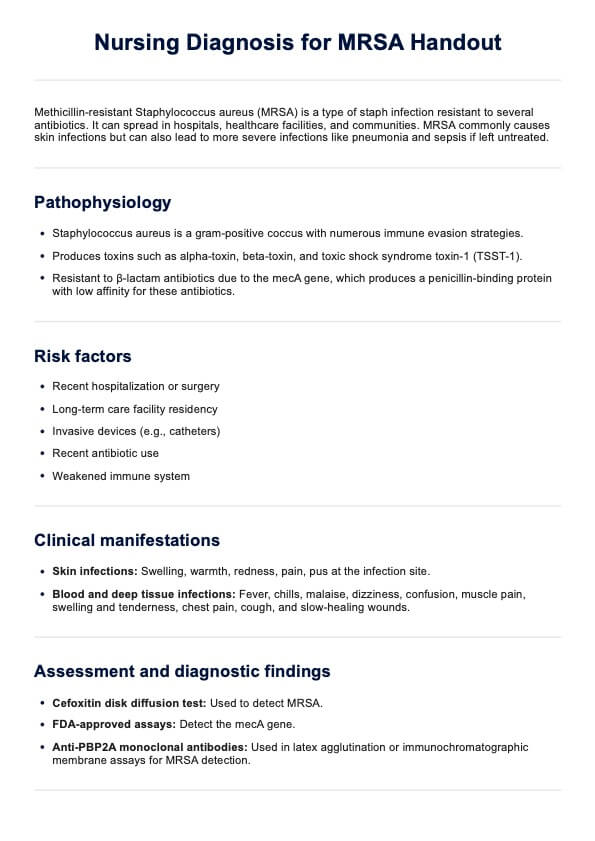How nurses assess and diagnose MRSA infections
When there are possible MRSA bloodstream infections, nurses use various assessment techniques to determine the severity and location of the MRSA colonization. This includes:
Symptoms and initial assessment
Nurses should be vigilant in identifying symptoms of an MRSA infection in the body, which can vary depending on the infection site. Common signs of a worsening infection include:
- Skin infections: Red, swollen, and painful pus-filled areas.
- Fever and pain: High body temperature and acute pain at the injection site.
- Respiratory infections: Cough, shortness of breath, and chest pain.
- Systemic symptoms: Fatigue and muscle or joint pain.
- Infected wound: Delayed healing, discharge, and increased pain.
- Urinary tract infections: Frequent urination, burning sensation, and cloudy urine.
- Sepsis: Rapid breathing, elevated heart rate, chills, and confusion.
Besides these physical symptoms, nurses should also assess a patient's risk factors for MRSA, such as recent hospitalization, surgery, or other invasive procedures. It is important to note that many people may carry MRSA without showing any signs of infection.
Diagnostic tests
Diagnostic tests for MRSA involve several key methods to accurately identify the presence of the bacteria:
- Cefoxitin disk diffusion test: Recommended by the Clinical and Laboratory Standards Institute (CLSI), this test involves using a cefoxitin disk on a Mueller-Hinton agar plate supplemented with 4% NaCl to detect MRSA. This method provides reliable results and is widely used in clinical laboratories.
- FDA-approved assays: Various FDA-approved molecular assays are available for detecting the mecA gene, which is responsible for MRSA's resistance to β-lactam antibiotics. These assays are highly sensitive and specific, making them reliable for confirming MRSA infections.
- Anti-PBP2A monoclonal antibodies: These antibodies can be used in latex agglutination or immunochromatographic membrane assays to detect the presence of PBP2a, a protein associated with MRSA resistance. These tests are quick and provide accurate results.
- Commercially available chromogenic agars: These agars are used for screening MRSA, providing a visual indication of bacterial presence through color change.
Vital signs monitoring
Regular monitoring of vital signs is essential to identify potential complications and ensure early intervention. Here are the key indicators to track:
- Temperature: Monitoring body temperature helps detect fever, which can be an early sign of infection.
- Heart rate and blood pressure: Closely monitoring heart rate and blood pressure is crucial for identifying signs of sepsis, cardiovascular problems, or other underlying conditions. Sudden changes can indicate a need for immediate medical intervention.
- Respiratory rate: Assessing respiratory rate is vital to identify respiratory distress or complications such as pneumonia.
Incorporating regular checks of these vital signs into a healthcare routine can significantly improve patient outcomes by allowing for timely diagnosis and treatment.
Infection control measures
Implementing stringent disease control measures is crucial in initiating infection control and preventing the spread of MRSA. These include:
- Hand hygiene: Strict protocols for proper hand hygiene among staff and visitors are essential. Regular and thorough hand washing with soap and water or using alcohol-based hand sanitizers can significantly reduce the risk of transmission.
- Personal protective equipment (PPE): Appropriate PPE, such as gloves, gowns, and masks, is necessary to protect healthcare workers and prevent the spread of infection. Proper donning and doffing techniques for PPE should be followed diligently.
- Isolation procedures: Implementing isolation procedures for infected patients helps contain the infection and prevent it from spreading to other patients, staff, and visitors. This includes placing infected patients in private rooms or designated isolation areas and restricting their movement within the healthcare facility.












